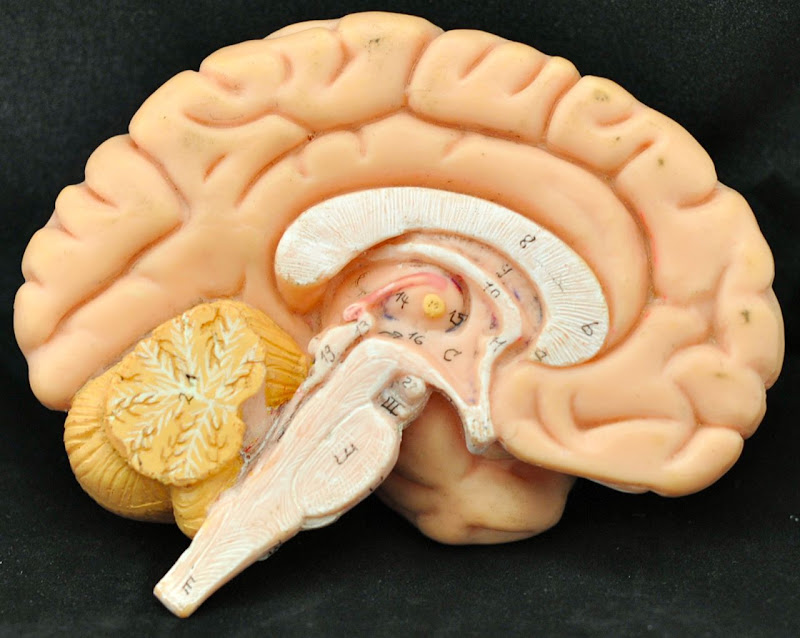The average score for the lab section #1 (8 A.M.) was only 54%, and for the section #2 (10 A.M.) 63%. These are the lowest scores we've ever seen on any practical . . . You should get your individual scores by the end of the week, after all lab instructors grade their groups, and we adjust the scores.
In meantime, I would like to encourage you to start studying for the next lab. (We'll start working on the brain! We might even get some real human brains for you.) There won't be an entrance quiz at the beginning of the lab, but it's always a good idea to come prepared for the class. That way you'll use your time in the lab more efficiently. At the very minimum familiarize yourself with the following figures from the
Chapter 12 in your text: 12.6; 12.12; 12.15; and 12.31.
Practical #1 Questions and Answers
STATION 1 (Scapula)
1. Identify A – Coracoid process
2. Identify B – Supraspinous fossa
3. Identify C – Medial border
STATION 2 (Atlas + Axis)
1. What does A articulate with? – Occipital condyles
2. Identify B – Dens
3. What movement occurs at the joint between C1 and C2? – Head rotation/shaking (Not nodding)
STATION 3 (Humerus)
1. Identify A – Deltoid tuberosity
2. Identify B – Capitulum
3. Identify C – Coronoid fossa
STATION 4 (Torso Model)
1. Name the cavity in which A is located? – Pleural cavity
2. What kind of membrane lines A? – Serous membrane
3. What plane is this? – Midsagittal/Sagittal plane
STATION 5 (Midsagittal section of the skull)
1. Identify A – Frontal sinus
2. Identify B – Internal acoustic/auditory meatus
3. In which bone is B located? – Temporal bone (petrous portion of the temporal bone)
STATION 6 (Hip Bone)
1. Identify A – Acetabulum
2. Identify B – Greater sciatic notch
3. Identify C – Auricular surface
STATION 7 (Tissue: Skin)
1. Identify layer A – Stratum granulosum
2. Identify layer B – Stratum spinosum
3. Which pigment-containing cells can you find in the layer C? – Melanocytes
STATION 8 (Roof of the cranium, Fetal skull)
1. Identify A – Lambdoidal/lambdoid suture
2. Identify B – Fontanelle
3. Identify C – Occipital bone (Basioccipital bone)
STATION 9 (Femur, Patella)
1. Identify A – Lesser trochanter
2. Identify B – Lateral epicondyle
3. Identify C – Apex of patella
STATION 10 (Vertebrae)
1. What kind of tissue is A made of? – Fibrocartilage
2. What is the primary cell type found in this tissue? – Chondrocyte/Chondroblast
3. What is the primary fiber type found in this tissue? – Collagen
STATION 11 (Skin model)
1. Identify A – Sweat/Sudoriferous gland
2. Identify B – Arrector pili muscle
3. Identify C – Nerve/Nerve ending/Pacinian corpuscule
STATION 12 (Ulna)
1. Identify A – Radial notch (of ulna)
2. Identify B – Olecranon (process)
3. Is it left or right bone? Left
STATION 13 (Tissue: Bone)
1. What goes through A? – Blood vessels and nerves (both answers needed)
2. Identify B – Lamellae
3. What is the primary fiber type found in this tissue? – Collagen
STATION 14 (Ribs, Lumbar vertebra)
1. Identify A – Xiphoid process
2. What kind of tissue is B made of? – Hyaline cartilage
3. Identify C – Spinous process of the lumbar vertebra (both parts of the answer needed)
STATION 15 (Pelvis)
1. Identify A – Pubic symphysis
2. Identify B – Anterior inferior iliac spine
3. Identify C – Ischial ramus
STATION 16 (Mandible, Skull)
1. Identify A – Symphysis of the mandible/Mandibular symphysis/Symphysis menti
2. Identify B – Petrous portion of the temporal bone (both parts of the answer needed)
3. Identify C – Maxilla
STATION 17 (Tissues: Simple columnar w/microvilla #1 and Psuedostratified columnar w/cilia #2)
1. Which of these two tissues has cilia? – #2
2. Where can you find the tissue #2? – Trachea, or Upper Respiratory Tract/Nasal Cavity/Larynx/Pharynx (Sperm ducts/Vas deferens/Ductus deferens have non-ciliated pseudostratified ephitelium; Epidydymis have stereocilia)
3. Identify C – Goblet cells
STATION 18 (Tibia, Fibula)
1. Identify A – Intercondylar eminence
2. Identify B – Medial malleolus of tibia
3. Identify C – Head of fibula (both parts of the answer needed)
STATION 19 (Rib, Cervical vertebra)
1. Identify A – Transverse foramen of the cervical vertebra (both parts of the answer needed)
2. Identify B – Head of the rib (both parts of the answer needed)
3. What does B articulate with? – Coastal facets/Coastal demi-facets/ Superior and inferior coastal demi-facets/body of the thoracic vertebra (both parts of the answer needed)
STATION 20 (Cell Model)
1. Identify A – Mitochondria
2. Identify B – Golgi
3. What cellular process is C involved in? – Mitosis/Cell division/Microtubule organization/Cytokinesis
STATION 21 (Foot)
1. Identify A – Navicular
2. Identify B – #4 (right) metatarsal
3. How many phalanges are in the right foot? – 14
STATION 22 (Skull)
1. Identify A – Superior nuchal line
2. Identify B (the indentions) – Cribiform plate (Not Crista galli)
3. What does pass through the openings in B? – Olfactory nerves
STATION 23 (Skull)
1. Identify A – Nasal bone
2. Identify B – Greater wing of the sphenoid bone (both parts of the answer needed)
3. Part of which bone is C? – Temporal bone (Not zygomatic bone)
STATION 24 (Radius, Clavicle)
1. Identify A – Styloid process of radius (both parts of the answer needed)
2. Identify B – Radial tuberosity (of radius)
3. Identify C – Sternal end of the clavicle (both parts of the answer needed)
STATION 25 (Tissue: Skin)
1. Identify tissue type (A) – Keratinized stratified squamous epithelium (full description needed)
2. Identify tissue type (B) – Dense irregular/Connective tissue
3. What is the primary function of the tissue A? – Protection/Moisture maintenance





















































